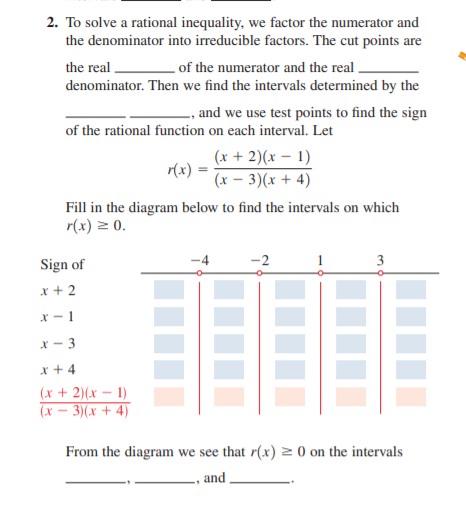2. To solve a rational inequality, we factor the numerator and the denominator into irreducible factors. The cut points are the real of the numerator and the real. denominator. Then we find the intervals determined by the -, and we use test points to find the sign of the rational function on each interval. Let (x + 2)(x – 1) r(x) = (x – 3)(x + 4) Fill in the diagram below to find the intervals on which r(x) 2 0. 3 Sign of x + 2 x - 1 x - 3 x + 4 (x + 2)(x – 1) (x – 3)(x + 4) From the diagram we see that r(x) 2 0 on the intervals , and
2. To solve a rational inequality, we factor the numerator and the denominator into irreducible factors. The cut points are the real of the numerator and the real. denominator. Then we find the intervals determined by the -, and we use test points to find the sign of the rational function on each interval. Let (x + 2)(x – 1) r(x) = (x – 3)(x + 4) Fill in the diagram below to find the intervals on which r(x) 2 0. 3 Sign of x + 2 x - 1 x - 3 x + 4 (x + 2)(x – 1) (x – 3)(x + 4) From the diagram we see that r(x) 2 0 on the intervals , and
Algebra and Trigonometry (6th Edition)
6th Edition
ISBN:9780134463216
Author:Robert F. Blitzer
Publisher:Robert F. Blitzer
ChapterP: Prerequisites: Fundamental Concepts Of Algebra
Section: Chapter Questions
Problem 1MCCP: In Exercises 1-25, simplify the given expression or perform the indicated operation (and simplify,...
Related questions
Question
To solve a rational inequality, we factor the numerator and
the denominator into irreducible factors. The cut points are
the real of the numerator and the real
denominator. Then we find the intervals determined by the
, and we use test points to find the sign
of the rational function on each interval. Let

Transcribed Image Text:2. To solve a rational inequality, we factor the numerator and
the denominator into irreducible factors. The cut points are
the real
of the numerator and the real.
denominator. Then we find the intervals determined by the
-, and we use test points to find the sign
of the rational function on each interval. Let
(x + 2)(x – 1)
r(x) =
(x – 3)(x + 4)
Fill in the diagram below to find the intervals on which
r(x) 2 0.
3
Sign of
x + 2
x - 1
x - 3
x + 4
(x + 2)(x – 1)
(x – 3)(x + 4)
From the diagram we see that r(x) 2 0 on the intervals
, and
Expert Solution
This question has been solved!
Explore an expertly crafted, step-by-step solution for a thorough understanding of key concepts.
This is a popular solution!
Trending now
This is a popular solution!
Step by step
Solved in 3 steps

Knowledge Booster
Learn more about
Need a deep-dive on the concept behind this application? Look no further. Learn more about this topic, algebra and related others by exploring similar questions and additional content below.Recommended textbooks for you

Algebra and Trigonometry (6th Edition)
Algebra
ISBN:
9780134463216
Author:
Robert F. Blitzer
Publisher:
PEARSON

Contemporary Abstract Algebra
Algebra
ISBN:
9781305657960
Author:
Joseph Gallian
Publisher:
Cengage Learning

Linear Algebra: A Modern Introduction
Algebra
ISBN:
9781285463247
Author:
David Poole
Publisher:
Cengage Learning

Algebra and Trigonometry (6th Edition)
Algebra
ISBN:
9780134463216
Author:
Robert F. Blitzer
Publisher:
PEARSON

Contemporary Abstract Algebra
Algebra
ISBN:
9781305657960
Author:
Joseph Gallian
Publisher:
Cengage Learning

Linear Algebra: A Modern Introduction
Algebra
ISBN:
9781285463247
Author:
David Poole
Publisher:
Cengage Learning

Algebra And Trigonometry (11th Edition)
Algebra
ISBN:
9780135163078
Author:
Michael Sullivan
Publisher:
PEARSON

Introduction to Linear Algebra, Fifth Edition
Algebra
ISBN:
9780980232776
Author:
Gilbert Strang
Publisher:
Wellesley-Cambridge Press

College Algebra (Collegiate Math)
Algebra
ISBN:
9780077836344
Author:
Julie Miller, Donna Gerken
Publisher:
McGraw-Hill Education